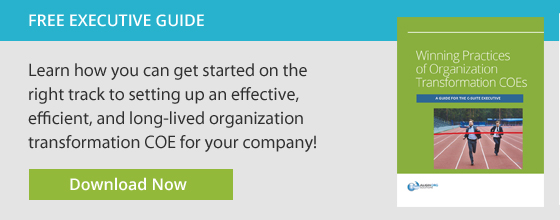A healthy organization transformation COE works in an organized, systematic, and efficient way to assist in implementing organizational change within an organization. However, without a clearly defined methodology (e.g., body of approaches, frameworks and tools), the COE will simply function as a collection of individual practitioners rather than an authoritative center of expertise in change transformation. This often defeats the purpose of efficiency.
It can be challenging to know which tools and methodologies will best serve the needs of your organization. Let’s explore some of the ways leaders can determine the right models, toolkits, and approaches to allow their COE to meet its client demand effectively and efficiently.
Change Transformation Methodology and Tool Kit: Build, Buy or Modify?
A new COE will always face the question of whether to build something internally or to find and adopt a proven, ready-made set of tools and methodologies. There are pros and cons to both approaches.
Building or developing one’s own toolset offers the clear advantage of creating a tool or methodology that is fully in sync with the culture and language of the organization. This helps ensure that the tools are easy for organization members to understand and use.
On the other hand, it is very easy to create a product that fails to follow through with best practices. Too often, tools developed in house become so customized to the organization’s thinking and culture that they lose the objectivity and rigor needed to deliver insights and results.
Further, developing proprietary products and processes can often take significant time. COE members heavily involved in building a tool kit and ramping up an approach may not be contributing significantly to the organization’s change transformation goals and efforts.
An organization that wants to get their COE up and running quickly is often better served by simply purchasing or licensing a ready-made and proven option and getting to work. For instance, many of our most successful clients have saved time and resources by licensing our organization design tools and methodologies to execute a quick start with best-in-class materials right away.
A third option, which many organizations have taken, is to use a hybrid approach. Tweaking or adjusting a ready-made tool kit or methodology to your organization’s unique needs can result in a best-of-both-worlds solution that offers the customized fit of an in-house product without having to spend large amounts of time and effort developing it from scratch.
Selecting the Best Tools and/or Methods for Your Organization
Whether you choose to build or buy, keeping a few underlying principles in mind can help you choose tools and methodologies that function well rather than being a source of frustration. Throughout the selection process, look for tools and methodologies that are:
- Supportive of discussion. The best change transformation tools encourage leaders to examine and discuss the options and choices they are facing, rather than simply spitting out answers or recommendations without letting leaders examine their own logic or thinking. One tool we use is called the ANCHOR (an acronym that stands for Audience, Need, Channel, Omit, and Revenue). Instead of plugging values into a formula, the ANCHOR tool encourages a robust discussion among leaders about what is important to the organization and how it intends to deliver value to customers. Some of the discussions using this tool have been truly transformative.
- Uncomplicated. Look for tools that are powerful, but simple. The best tools are easy to use and simple enough to understand that a quick white board orientation is enough to enable people to immediately put it to use, at least to the extent of helping them have a discussion or take some kind of action that will move them forward.
- Connected. The best tools also are connected, and leverage language that is common or understood in the organization. You never want members of the organization to feel like the tool is a check-the-box exercise, but rather a logical next step in a strategic discussion or thought process. A good tool will virtually baby step the user through the process to get to the desired conclusion. Returning to the example of the ANCHOR tool, this is just one of many tools in our organization design methodology, but it flows seamlessly into the next step of the process so that leaders find using it feels natural, not clunky.
How to Avoid Overwhelming or Overly Complicated Methodologies
One common pitfall in tool and methodology selection is to develop or acquire one tool here and one there with little regard to how they relate to each other. The result can be a confusing hodge-podge of approaches that lead to an overwhelming or overly complicated approach.
To ensure that the various change transformation toolkits and methodologies you select are well integrated, take the time to think through how each one connects with other tools and methods that might be used in the company. For example, a while back we did some organization design work with a large science and technology firm. One element of this work touched on process design. This company has a contingent of internal Six Sigma practitioners who are very comfortable analyzing, redesigning and driving improvements for processes. While we have our own set of tools for this work, we decided to use their Six Sigma tools for process design work resulting from organization design efforts at this company, rather than invite confusion by introducing an unfamiliar method or toolset.
In this case, using their existing tools ensured that the integration work was complimentary rather than confusing or overly complex. But because each case is different, it is important to consider available choices and choose the “best of breed” approach for each unique situation.
Select Tools With Results In Mind
With the huge variety of options available, selecting the right tools and methodologies for your change transformation CEO can be a complex and confusing task. It is easy to get bogged down in comparing pros and cons of specific features, but choosing simple, straightforward solutions that keep processes flowing smoothly is typically the approach that will best serve the strategic goals of the organization.







